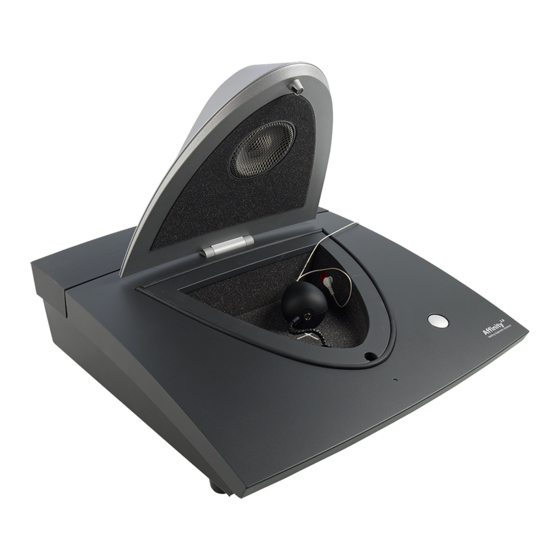
Table of Contents
Advertisement
Quick Links
Quick Guide
SKS10 skull simulator
Introduction
This Quick Guide is intended to provide guidelines on how to use the Interacoustics SKS10 Skull Simulator for
bone anchored hearing devices.
Background information
How do bone anchored systems work?
Bone anchored hearing systems transfer sound to the cochlea via direct bone conduction, bypassing the outer
and middle ear. This is similar to the way that sound is transmitted to the inner ear when conducting bone
conduction audiometry. With bone-anchored hearing devices, however, it is direct bone conduction; that is, the
vibrations do not have to pass through the skin. They are sent directly to the cochlea via the bones of the skull.
Therefore, the way that sound is conducted to the inner ear is completely different compared to traditional air
conduction hearing aids. With air conduction hearing aids, the output of the hearing aid is measured in dB SPL
(sound pressure level). With bone anchored devices, the output needs to be measured as output force level, in
dB µN (micro Newton).
Images courtesy of Oticon Medical. www.oticonmedical.com
What is a skull simulator?
Similar to a 2cc coupler used with traditional air conduction hearing aids, the skull simulator is a coupler on
which bone anchored hearing devices can be attached. It will convert the force output of the bone-anchored
device to an electrical signal. With this new device, end users will be able to perform measurements on bone
anchored hearing devices and evaluate if they are functioning as expected or not.
D-0103838-B – 2019/05
Page 1 of 6
Advertisement
Table of Contents

Summary of Contents for Interacoustics SKS10
- Page 1 Quick Guide SKS10 skull simulator Introduction This Quick Guide is intended to provide guidelines on how to use the Interacoustics SKS10 Skull Simulator for bone anchored hearing devices. Background information How do bone anchored systems work? Bone anchored hearing systems transfer sound to the cochlea via direct bone conduction, bypassing the outer and middle ear.
- Page 2 2. To copy the serial number: go to Menu/Help/About, click on License and select “Copy s/n”; this will copy the serial number to the Clipboard. 3. Paste the serial number in the body of an email and mail it to Interacoustics. 4. Interacoustics will then email a new HIT license.
- Page 3 Activating the new HIT license: 1. Go to HIT module/Menu/Help/About. 2. Click on License. 3. Paste the new license number under HIT/New license. The Skull protocol might be hidden in the software. To activate it: 1. Go to HIT/Menu/Setup/HIT440 setup. 2.
- Page 4 4. Plug it into the measurement microphone plug of the test chamber. Affinity NOTE: it is also possible to use the SKS10 with the TBS25 test chamber. 5. Snap the bone anchored device onto the abutment of the skull simulator.
- Page 5 8. Launch the Affinity software. 9. When Affinity software is open, select the HIT tab. 10. Choose a test protocol from the drop down menu. 11. Click START to begin the test. NOTE: The Affinity has a default Skull Simulator protocol, which takes element from the ANSI standard for Hearing Instruments.
- Page 6 2. To re-initiate the Skull Coupler Setup Guide startup window, go to Menu/Setup/General Setup and insert checkmark in the “Show setup guide” box. For further information on the SKS10 and creating or customising protocols, please refer to the Interacoustics Additional Information document.




Need help?
Do you have a question about the SKS10 and is the answer not in the manual?
Questions and answers